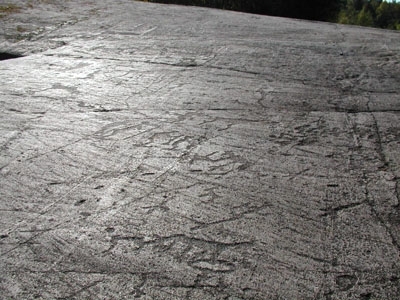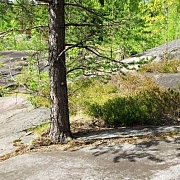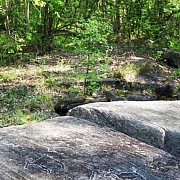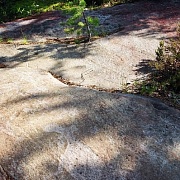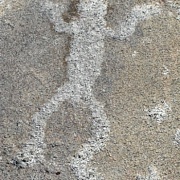The White Sea carvings - petroglyphs - were created about 6 thousand years ago by ancient hunters and fishermen. They are considered to be one of the most outstanding monuments of the primitive art in Northern Europe.
Petroglyphs are situated on the scenic islands in the lower reaches of the Vyg River as compact accumulations. Besovy Sledki and Zalavruga are the most famous groups. Among the 2000 images carved on the gently sloping rocks there is the "Demon" figure - probably the magic of fertility.
There are many expressive scenes of elk, bear and whale hunting, ritual and war actions, image of the boat with dozens of oarsmen. One can see here the oldest in Europe figure of skiing man, the bird hunter with boomerang.
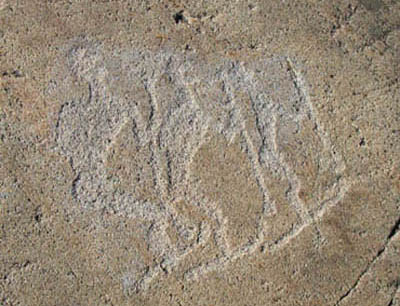 |
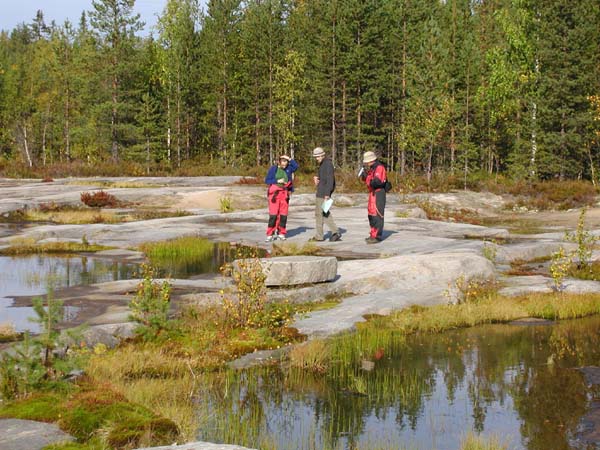 |
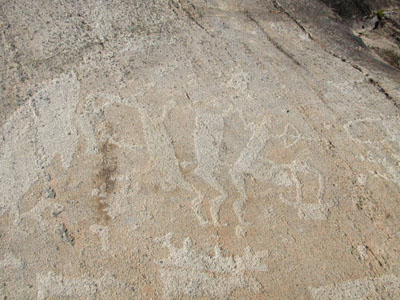 |
Scientists have found more than 70 ancient sites of long and short duration next to the White Sea rock art. The unique grave with masonry and lots of amber adornments and flint arrow points have been excavated.
Durations, groups of petroglyphs with it's surroundings form a unique archeological complex. The tourist route "Belomorskie petroglyphs" goes through it's territory.
Besovy sledki
The petroglyphs "Besovy Sledki" (the northern group) cover a small rock exposure in the north part of Shoiruksha island, which is located at the center of Vyg river and borders with Shoiruksha rapid. Its surface is smooth and it slopes to the water. The area of 40 square meters is filled with the pictures. Cracks and break-ups divide the rock into separate pieces, which differ in color and the condition of the surface. The main explorer of Besovy Sledki Linevsky registered 300 pictures here.
Along the lower edge of the rock there is a chain of traces of a naked foot (7 traces), which ends with a human figure, situated to the north of the main massif of pictures. The figure is humpbacked with a disproportionately large phallus and foot, an arm with five bristling fingers is outstretched. There are chin, mouth, nose, forehead at the face of the figure and an outgrowth, may be a sharp ear or a part of a hat at the back of the head. The man is pictured half face. This unusual picture was named Devil and the whole group, including the chain of traces, got the name of Devil’s traces, (which is Besovy Sledki in Russian). Having studied the figure of the devil and the chain of traces, the explorers decided that this is the picture of a spirit – the master of water elements.
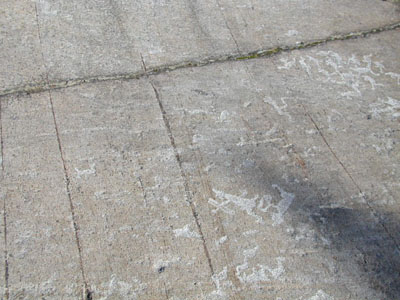 |
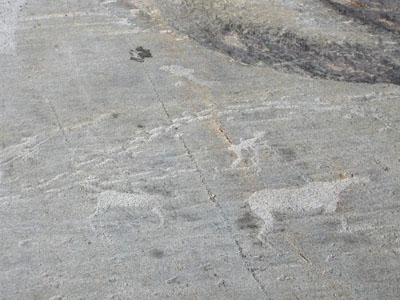 |
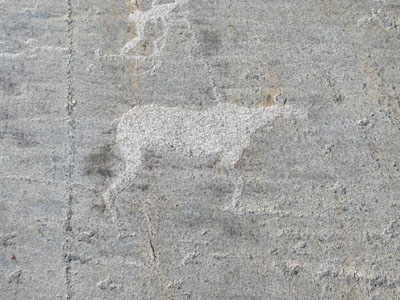 |
Linevsky also states that there were different stages in making the pictures. The researcher singled out three stages of infilling the rock. At first, sea animals, the scenes of sea trade and some other pictures (two elks, a deer and a goose) appeared on the southern part of the rock. At the same time two large swans, deers and trade tools were made on its lower part. Some figures then appeared at the northern part of the rock, including devil and the southern trace. At the second stage compositions with human figures and other small animals were carved on the rock. And finally, six traces of the devil and a deer and an elk in the upper part of the rock appeared.
Sanctuary
Having found the petroglyphs of Besovy Sledki, Linevsky started searching for other traces of ancient people nearby. After gathering different stone tools and shards, he revealed thirteen sites of ancient people. But the collections were few in numbers and couldn’t show the life of the past in details.
In 1928-1929 Brjusov made additional exploring, which confirmed the existence of the sites. Indeed, the explorer preferred to name them locations for they served as the places of short stays. He also found a sanctuary – a large, filled with sand deepening in the rock, which is located near the petroglyphs of Besovy Sledki. During the archeological digs a reddish sand 30-85 cm thick was found under the layer of soil. Then common gray sand followed. Under it at a depth of 100-120 cm there was the second layer of dark sand, which was rich with discoveries. The bottom of the deepening was an artificially evened surface.
The central part of this room was of a quadrangular shape with the extension of 8 meters from west to east and 6-7 meters from south to north. The south and east walls were almost vertical about 100-170 cm high. There were three natural rocky steps to the deepening from the rock with petroglyphs.
On the bottom of the deepening there was a fire-place and three firesides made of stones. The main mass of the discoveries was made around the firesides. There was a huge stone between the petroglyphs and the entrance to the deepening.
Brjusov thinks that the room and the petroglyphs were some kind of a sanctuary with altar and religious pictures.
Some time later the water level in the river rose. The deepening in the rock and the rock carvings came under the water and were covered with sand. Then the water fell down.
On the way to Zalavruga
The second large gathering of rock carvings is situated 1.5 km from Besovy Sledki – at Zalavruga. There are also small groups of petroglyphs at the nearby islands.
Two smaller groups located on the east part of the island of Erpin Pudas are very interesting. The south group of Erpin Pudas is situated in the inland part of the island, on the left shore of a canal. It has only three drawings of deers. The pictures are hardly noticeable.
Some distance away there are the remains of the Erpin Pudas site. It is older than the petroglyphs and has appeared in the early III century AD. To the east there is another north group of Erpin Pudas. It consists of 28 small drawings. The drawings mainly show boats (18 figures). Sometimes they are with one-two rovers, sometimes empty. There are only two sea animals and the same number of ungulate animals, probably deers. Besides, there is a picture of a swan and two human pictures, one of them is en face. The latter is interesting for its tail, which connects it with a sea animal. Probably, this is a sea spirit, the protector of ancient sailors or another mythological figure. The north group of Erpin Pudas may be dated by late III – early II century AD. These drawings are a crossover to Zalavruga.
Zalavruga
The place of Zalavruga is an elevated part of the Malinin island. The area of a few hectares is called Zalavruga – its the place of long-term archeological researches. Here a very interesting complex of ancient monuments is located. It includes a group of petroglyphs, two ancient settlements and rock carvings, which have been recently found. Perhaps, there is no other place in Karelia, where antiquity and the present are neighboring.
The settlement is extended from northwest to southeast for a hundred meters. The locals did not know about the petroglyphs. Probably, they were newcomers and were not acquainted with the rock art. As the water level got lower, the shore became shallower and more waterlogged. The life on the island was getting uncomfortable, so the people had to leave Zalavruga.
The cultural layer of the settlement concealed the main riches of the island – rock carvings. Some of them came upon the bed of the channel and were covered with sand.
The old Zalavruga is one of the brightest gatherings of petroglyphs in Karelia.
While interpreting the drawings three gatherings were singled out: the main gathering (on the central rock) and two side ones. Altogether there are more than 200 registered pictures. This discovery is unique in its scientific meaning. Linevsky said "by its grandiosity, simplicity and clarity the rock of Zalavruga will surely take one of the first places among the monuments of ancient people". Unfortunately, the old Zalavruga is not well preserved.

